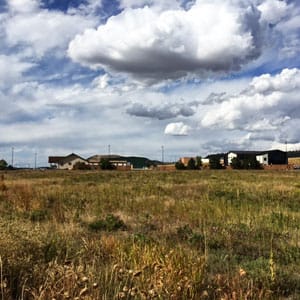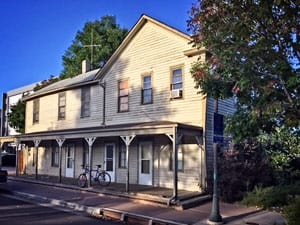Beans, biscuits, and New Memphis

The southern boundary view of New Memphis from Liggett Road. The northern boundary is the approximate location of the current-day Founders/Meadows Parkway bridge.
Article and photos by Joe Gschwendtner
Events in Colorado history didn’t really accelerate until the 59ers swarmed the Pikes Peak region, Russellville (near Franktown) included. By 1861, Colorado would become a territory and in another 15 years, attain statehood.
Those 17 years to statehood were tumultuous. No one suffered greater upheaval than the Native American. Immigration is our hot button today; consider what the Indian felt as torrents of settlers moved in to occupy his hunting grounds, contaminate his water, and fell his trees.
Douglas County pioneers were threatened by him, and rightly so, especially those on isolated homesteads. Some prevailing lore was that Native Americans enjoyed white man’s beans and biscuits. Thus, when so tantalized, they were less likely to harm settlers or burn their cabins down. Indian women were said to be fascinated with a settler woman’s chores. On receipt of Indian visitors, frightened pioneer women would go about their cooking, sewing, and mending as if on stage in a theater. Women left alone became adept not only at culinary bribery and theater skills, but lying by trying to convince Indian visitors that armed husbands were close by in the fields.

The Harris Hotel located at 415 Perry Street was originally owned by Thomas Harris and is a New Memphis relic. Harris relocated the hotel to Castle Rock along with his own political future.
Other hardships abounded. Farmers were often set upon by grasshopper invasions wiping out entire crops. With no dry-land farming experience, pioneers often produced puny harvests. Shortage of dry wood, poor heating and ventilation, dirt floors in a one-room cabin with wind ripping through the wall chinks all made for horrible winters. Creeks often dried up in the summer. Frontier life was anything but romantic.
Incredibly, there were already developers in the late 1800s. One was the National Land Development Company. Underwritten by expanding railroads, it sought to induce people to homestead along future railroad routes. Not inconveniently, these instant communities were practical solutions to protect against warring Indians and the loneliness and boredom of the prairie.
In 1871, a southwestern colony was organized in Tennessee to acquire land for a company town called New Memphis, south of today’s Founders/Meadows Parkway brige. Settled in 1871 with six families and a population of 50, it actually competed with Castle Rock to be the county seat by 1874.
Politics and gossip eventually doomed the colony. Local newspapers described it as a “red-hot lively town whose principal activity was horse-racing, gambling and drinking forty-rod whiskey.” While it offered far more, founder Thomas Harris took the insults personally and insinuated in print that Castle Rock was a mere “sand pile” itself. P.P. Wilcox of Castle Rock responded that “the whiskey in New Memphis might be good but not the water.”
In the end, Castle Rock prevailed. Seemingly overnight, the entire population of New Memphis moved south and the town became deserted. Harris though, fared better. He became Castle Rock’s second mayor in 1882. Had New Memphis survived, the residents would be our neighbors today. Personally, I think, the name has no panache. Certainly not in these Wildcat Mountains…